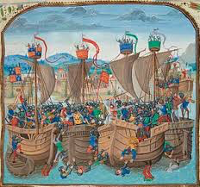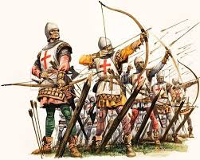King Edward III of England
Part 2: A Lifetime of War The main focus of the last few decades of Edward's reign was the French throne. King Charles IV of France had died in 1328, and he had not left behind a male heir. Charles was Edward's uncle (being Isabella's brother), and so Edward claimed that he was the heir to the French throne. Not long after Charles's death, Edward claimed the throne of France. In France, meanwhile, Charles's cousin Philip had assumed the kingship, becoming King Philip VI. Naturally, he didn't take kindly to Edward's claim of the French throne. He invaded Guienne, which was part of Aquitaine, the large area of France that had been property of English monarchs since King Henry II had married Eleanor of Aquitaine in 1152. Edward responded with military action of his own. Edward had renewed his claim to the French throne in 1337, and this is the official dating of the beginning of the Hundred Years War. It would consume the rest of Edward's reign and that of a handful of his successors. The one thing that Edward, and all of his successors, never seemed to have enough of was money. Time and again, wars were halted because of lack of funds. Edward and others sometimes stooped to very dubious means to acquire money to pay troops. 
Edward quickly made an important ally in Louis the Bavarian, gaining much-needed money and supplies and a base from which to invade France from the northeast. English forces won the naval Battle of Sluys in 1340 and gained control of the English Channel. Edward officially declared himself King of France in that year as well. 
England had some early successes, wielding the longbow to devastating effect at the Battle of Crécy, in 1346, and the Battle of Poitiers, in 1356. In between, English forces had won a long siege at Calais and seized that important port city. While Edward was focused on the south, Scotland took the opportunity to renew the conflict in the north. David II led an army into battle at Neville's Cross; the result was a resounding English victory, one that resulted in the capture of David II himself. Edward kept David captive, first in the Tower of London and then in more comfortable surroundings, for 11 years. After paying a huge ransom, he returned home in 1357 and resumed his reign. 
Coming into his own during this time the king's oldest son, also named Edward. He was officially known as Edward, Prince of Wales, but he also often referred to as the Edward the Black Prince. He was just 16 when he led the English Army to victory at Crécy. He had, at Poitiers, not only routed the French but also captured the French king, John II. After a lull, during which John II died, the two countries hammered out a peace agreement, the Treaty of Bretigny, in 1360. Edward agreed to renounce all claims to the French crown; in return, France agreed to restore Aquitaine to him. After another considerable lull, France seized the initiative, declaring war in 1369. Edward III by this time was too old to take the field and left the fighting to his sons. France began to turn the tide. Next page > And in the End > Page 1, 2, 3 |
|
Social Studies for Kids
copyright 2002–2025
David White




